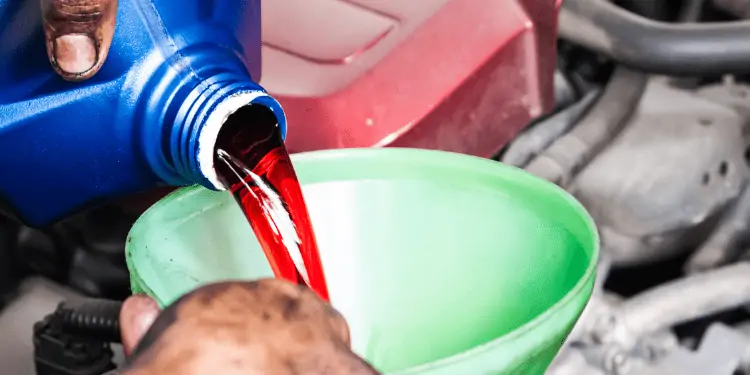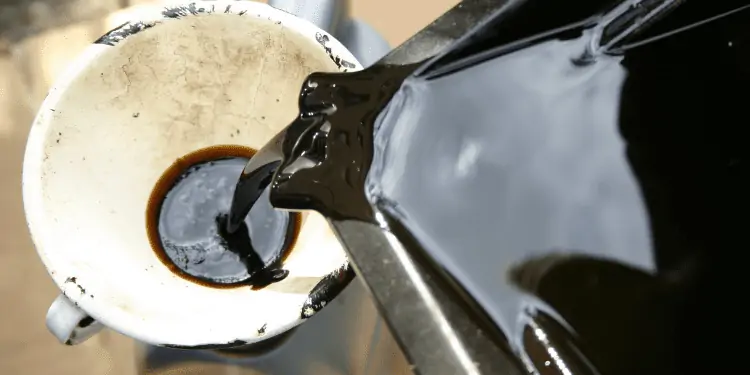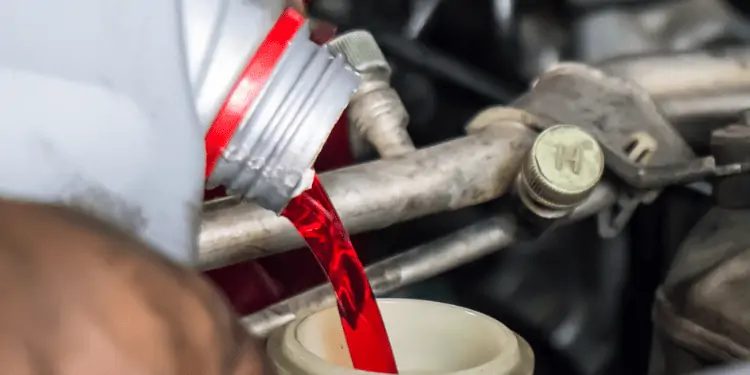So you’ve got a fluid leaking under the hood. There are many fluids, but we’ll concentrate on oil and transmission fluid leaks in the article.
Engine Oil and Transmission Fluid Colors
The easiest way to tell the difference between the two fluids is their color. However, even this can be problematic.
If the transmission fluid and engine oil are new, it’s easy.
- New transmission fluid is red
- New oil is amber or golden in color
Both engine oil and transmission fluid are made from crude oil. As it ages in your car, the additives added during manufacturing begin to separate. This changes the color of both oil and transmission fluid.
- Older engine oil changes from amber to either a dark brown or black color.
- Older transmission oil changes to a brown color.
As you can see, there is a crossover between the colors if the fluids are old so let’s move on to another difference.

Viscosity Difference Between Transmission Fluid, Gear Oil, and Engine Oil.
Although these fluids are oil/petroleum-based, there are differences.
Transmission fluid is more free-flowing and fluid. This is called low viscosity. The lower the viscosity, the easier the fluid flows through the system. The transmission on your car has more delicate components than other parts, and heavier oil wouldn’t lubricate it effectively.
I’ll briefly touch on gear oil – for manual cars. This oil is heavier than transmission fluid. There are fewer parts in a manual gearbox, and they are larger and more robust. Hence the increased thickness.
Engine oil is thicker than transmission fluid. It is subjected to higher pressure and more extremes of heat. A less viscose fluid wouldn’t be able to withstand the rigors of a car engine.
As already stated, older engine oil and transmission fluid change with age. It’s not just color, though.
Both these fluids thicken up as they age. This is due to the changing oil molecules and contamination from water, dirt, and debris entering the circuit.

Although it’s not good to expose skin to oil-based fluids long-term, rolling it briefly between the finger and thumb can indicate what the leak comprises.
To do this, you need a frame of reference. A good idea would be to take the engine dipstick out and feel its viscosity. Then quickly feel the leaking fluid and compare. If the leak feels the same as the oil on the dipstick, it’s likely engine oil. If the dipstick sample feels heavier than the leak, then the leak is likely to be transmission fluid.
Difference Between Engine Oil and Transmission Fluid Smell
This is very subtle; to most people, the difference in smell isn’t noticeable.
It’s worth noting if you’re smelling burning oil, it could be either engine oil or transmission fluid. There will be no discernable difference.
However, transmission fluid – especially newer – smells sweet, whereas engine oil smells more like petroleum in the absence of either fluid burning.
Many visitors also read this article: What Does Car Oil Smell Like? New, Old and Burning [ANSWERED]
Check Transmission Fluid and Engine Oil Levels
I won’t touch on this too much as it doesn’t take much explaining. This can be the easiest way of checking where the leak is coming from.
It will only work if you were aware of the levels of both fluids before you became aware of the leak. If you know that both levels were fine, and now you see one level is lower than it was, there is a good chance that that is the one that is leaking.
Despite the best will in the world, it’s unlikely that you’ll know this for sure. You’ll have to top up both systems to the max line and see which one falls.

Note well: Driving with leaking fluids is risky and could cause a lot of damage to the engine or transmission if the leak is bad. It is better to top up the fluids and leave the car parked for several days. This isn’t possible for many people who need their cars daily.
Add to this that the leak may only present itself when the car is running. A leak is more likely when the systems are pressurized, which only happens when the key is turned.
Location of Engine Oil and Transmission Fluid Leak
Both these systems are located under the hood, so it can be difficult to assess which one is leaking purely on where the fluid is on the pavement.
If your car is rear-wheel drive, the transmission will likely be further back towards the dashboard and behind the engine. Therefore, any transmission fluid leak is likely further back toward the cabin. The leak may run down the driveshaft on rear-wheel cars and deposit the leak under the cabin instead.
An engine oil leak can result from a leak from the piston rings, head gasket, or timing cover. A head gasket and timing cover leak are visible without getting under the car or jacking it up, but gravity will mean the oil will end up on your drive. A damaged oil pan or leaking oil filter won’t be visible from above.
An internal oil leak, such as piston rings – often shows blue smoke from the tailpipe. This can be subtle but is often a more expensive repair involving opening up the engine and replacing parts.
Transmission fluid can leak from the shaft seal, transmission pan, pan gasket, seals, or torque converter. None of these are easy to see and require the car to be jacked and inspected from below.
What’s Cheaper To Repair – Engine Oil Leak or Transmission Fluid Leak
This is a really difficult question to answer.
The cheapest fix is a gasket or seal leaking because it becomes brittle or damaged. However, often they leak due to an increase in fluid pressure caused by a failing part within the engine or transmission.
A torque converter is a very expensive transmission part. It’ll cost around $1000 for the part and labor. If a seal needs replacing, expect to pay around $150. Only a small amount is the seal itself, and the rest will be labor costs.
The cheapest oil leak repair is where the filter leaks. This is because the oil filter isn’t an internal engine part, a competent DIY mechanic can replace it, and few special tools are needed.
Crankshafts, pistons, and valve seals are at the high end of repairs. These repairs involve taking the top off the engine and replacing parts. The labor costs involved are high, and parts can be expensive.
If you’re confident that the leak is from a damaged seal and not an internal part, it may be worthwhile trying a transmission or oil sealant solution. These products are cheap, easy to use – pour in – and, if work, can save a lot of labor costs.
Even if they work, they provide a temporary fix that will allow you to plan a more permanent repair at a more convenient time.
In Summary
Whether the leak is oil or transmission fluid, it should be fixed as a matter of urgency. Sometimes the fix will cost no more than a few hundred dollars. If the leak worsens, it will cause severe damage to expensive parts within the transmission or engine.
Not only will the repair bill be high, but you’ll likely lose access to your car for many days while the car parts are ordered and the car waits in the shop to be repaired.
Oil Leak Signs
- Thicker to touch
- Amber if new
- More likely leaking midway under the hood.
Transmission Fluid Leak Signs
- Reddish color
- Sweet smell
- Less thick
- The leak is likely closer to the cabin.













